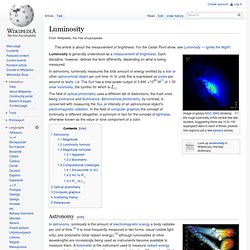

Astrophysics. Astrophysics. Interstellar medium. In astronomy, the interstellar medium (or ISM) is the matter that exists in the space between the star systems in a galaxy.

This matter includes gas in ionic, atomic, and molecular form, dust, and cosmic rays. It fills interstellar space and blends smoothly into the surrounding intergalactic space. Astronomical object. Above the round domes of La Silla Observatory, three astronomical objects in the Solar System — Jupiter (top), Venus (lower left), and Mercury (lower right).[1] Types of Solar System bodies.

Astronomical objects or celestial objects are naturally occurring physical entities, associations or structures that current science has demonstrated to exist in the observable universe.[2] The term astronomical object is sometimes used interchangeably with astronomical body. Typically, an astronomical (celestial) body refers to a single, cohesive structure that is bound together by gravity (and sometimes by electromagnetism). Examples include the asteroids, moons, planets and the stars. Astronomical objects are gravitationally bound structures that are associated with a position in space, but may consist of multiple independent astronomical bodies or objects. Electromagnetic spectrum. Electromagnetic radiation. The electromagnetic waves that compose electromagnetic radiation can be imagined as a self-propagating transverse oscillating wave of electric and magnetic fields.

This diagram shows a plane linearly polarized EMR wave propagating from left to right. The electric field is in a vertical plane and the magnetic field in a horizontal plane. The two types of fields in EMR waves are always in phase with each other with a fixed ratio of electric to magnetic field intensity. Electromagnetic radiation (EM radiation or EMR) is a form of radiant energy, propagating through space via electromagnetic waves and/or particles called photons.
Luminosity. Image of galaxy NGC 4945 showing the huge luminosity of the central few star clusters, suggesting there are 10 to 100 supergiant stars in each of these, packed into regions just a few parsecs across.

Luminosity is generally understood as a measurement of brightness. Each discipline, however, defines the term differently, depending on what is being measured. In astronomy, luminosity measures the total amount of energy emitted by a star or other astronomical object per unit time. In SI units this is expressed as joules per second or watts. I.e. Astronomy[edit] A star's luminosity can be determined from two stellar characteristics: size and effective temperature.[2] The former is typically represented in terms of solar radii, Cosmic microwave background. The cosmic microwave background (CMB) is the thermal radiation assumed to be left over from the "Big Bang" of cosmology.

In older literature, the CMB is also variously known as cosmic microwave background radiation (CMBR) or "relic radiation. " Mechanics. Classical versus quantum[edit] The major division of the mechanics discipline separates classical mechanics from quantum mechanics.

Historically, classical mechanics came first, while quantum mechanics is a comparatively recent invention. Classical mechanics originated with Isaac Newton's laws of motion in Principia Mathematica; Quantum Mechanics was discovered in 1925. Both are commonly held to constitute the most certain knowledge that exists about physical nature. Classical mechanics has especially often been viewed as a model for other so-called exact sciences. Statistical mechanics. Statistical mechanics is a branch of mathematical physics that studies, using probability theory, the average behaviour of a mechanical system where the state of the system is uncertain.[1][2][3][note 1] The present understanding of the universe indicates that its fundamental laws are mechanical in nature, and that all physical systems are therefore governed by mechanical laws at a microscopic level.

These laws are precise equations of motion that map any given initial state to a corresponding future state at a later time. There is however a disconnection between these laws and everyday life experiences, as we do not find it necessary (nor easy) to know exactly at a microscopic level the simultaneous positions and velocities of each molecule while carrying out processes at the human scale (for example, when performing a chemical reaction). Quantum mechanics. Wavefunctions of the electron in a hydrogen atom at different energy levels.

Quantum mechanics cannot predict the exact location of a particle in space, only the probability of finding it at different locations.[1] The brighter areas represent a higher probability of finding the electron. Quantum mechanics (QM; also known as quantum physics, quantum theory, the wave mechanical model, or matrix mechanics), including quantum field theory, is a fundamental theory in physics which describes nature at the smallest scales of atoms and subatomic particles.[2] Quantum mechanics gradually arose from theories to explain observations which could not be reconciled with classical physics, such as Max Planck's solution in 1900 to the black-body radiation problem, and from the correspondence between energy and frequency in Albert Einstein's 1905 paper which explained the photoelectric effect. History[edit] In 1838, Michael Faraday discovered cathode rays.
Where h is Planck's constant. Coulomb potential. Physics. Various examples of physical phenomena Physics is one of the oldest academic disciplines, perhaps the oldest through its inclusion of astronomy.[8] Over the last two millennia, physics was a part of natural philosophy along with chemistry, certain branches of mathematics, and biology, but during the Scientific Revolution in the 17th century, the natural sciences emerged as unique research programs in their own right.

[b] Physics intersects with many interdisciplinary areas of research, such as biophysics and quantum chemistry, and the boundaries of physics are not rigidly defined. New ideas in physics often explain the fundamental mechanisms of other sciences[6] while opening new avenues of research in areas such as mathematics and philosophy. Physics also makes significant contributions through advances in new technologies that arise from theoretical breakthroughs.
Light-year. The light-year is most often used when expressing distances to stars and other distances on a galactic scale, especially in non-specialist and popular science publications.

Thermodynamics. Annotated color version of the original 1824 Carnot heat engine showing the hot body (boiler), working body (system, steam), and cold body (water), the letters labeled according to the stopping points in Carnot cycle Thermodynamics applies to a wide variety of topics in science and engineering. Historically, thermodynamics developed out of a desire to increase the efficiency and power output of early steam engines, particularly through the work of French physicist Nicolas Léonard Sadi Carnot (1824) who believed that the efficiency of heat engines was the key that could help France win the Napoleonic Wars.[1] Irish-born British physicist Lord Kelvin was the first to formulate a concise definition of thermodynamics in 1854:[2] "Thermo-dynamics is the subject of the relation of heat to forces acting between contiguous parts of bodies, and the relation of heat to electrical agency.
" Introduction[edit] A thermodynamic system can be defined in terms of its states. History[edit] Universe. There are many competing theories about the ultimate fate of the universe. Physicists remain unsure about what, if anything, preceded the Big Bang. Many refuse to speculate, doubting that any information from any such prior state could ever be accessible.
There are various multiverse hypotheses, in which some physicists have suggested that the Universe might be one among many or even an infinite number of universes that likewise exist.[11][12] Historical observation.
Exoplanet. 2 January 2013: Astronomers state that the Milky Way may contain as many as 400 billion exoplanets, with almost every star hosting at least one planet.[1][2][3] An exoplanet or extrasolar planet is a planet outside the Solar System. Around 1800 such planets have been discovered[5][6][7] (1783 planets in 1105 planetary systems including 460 multiple planetary systems as of 18 April 2014).[8]